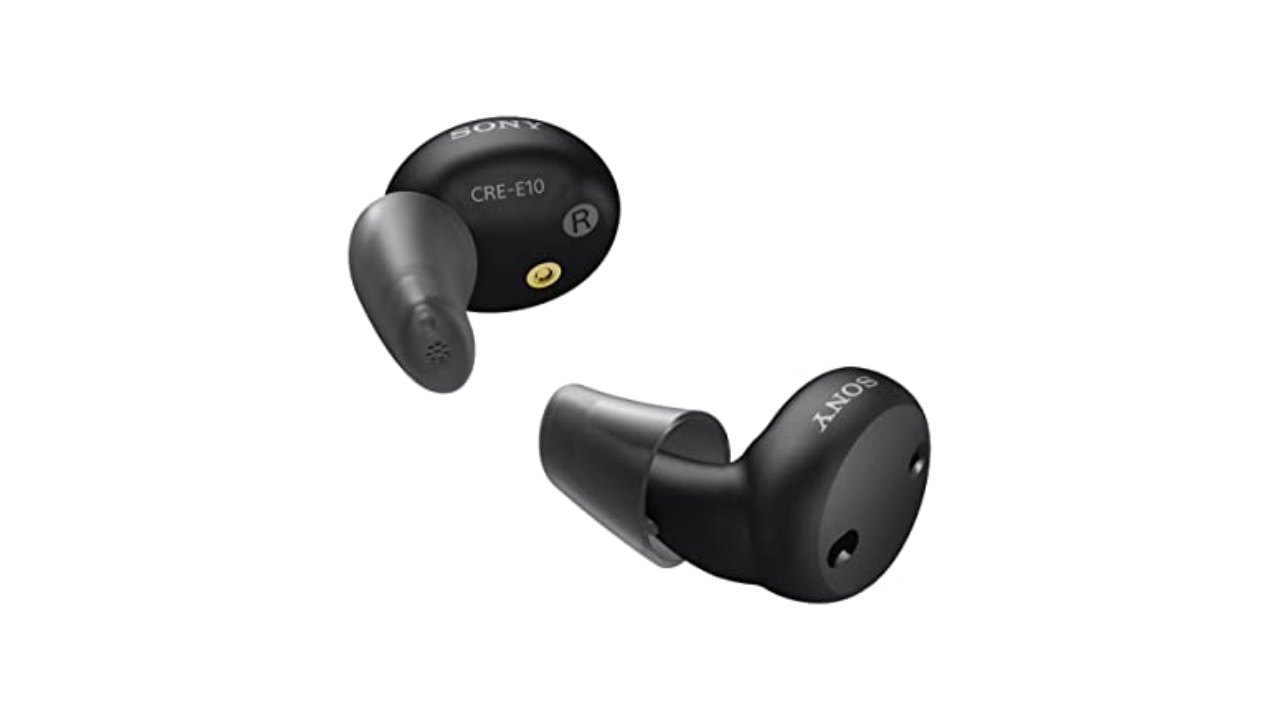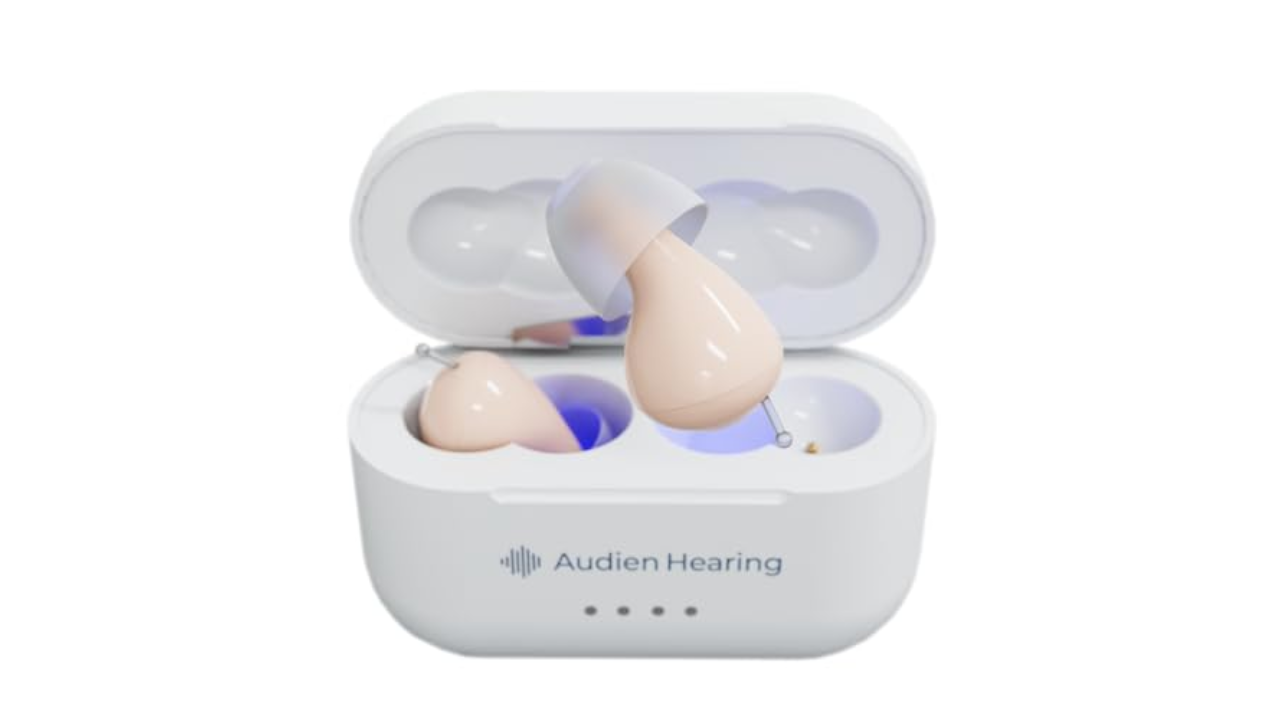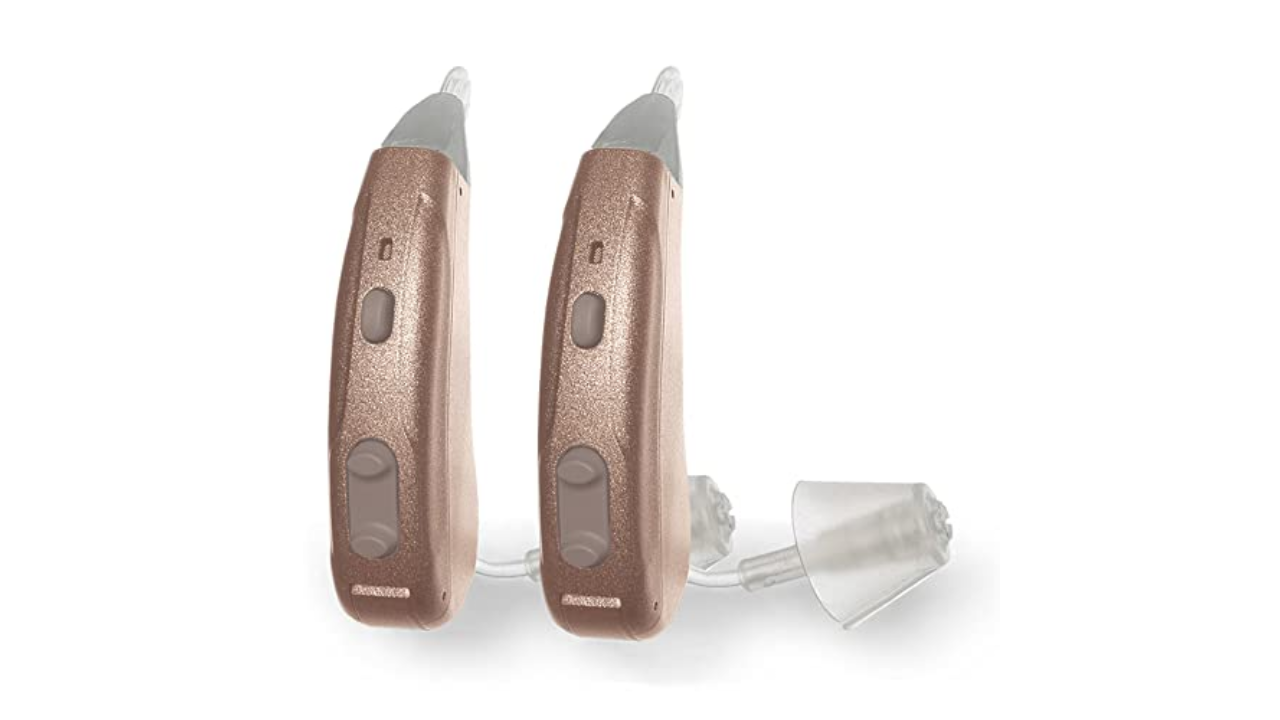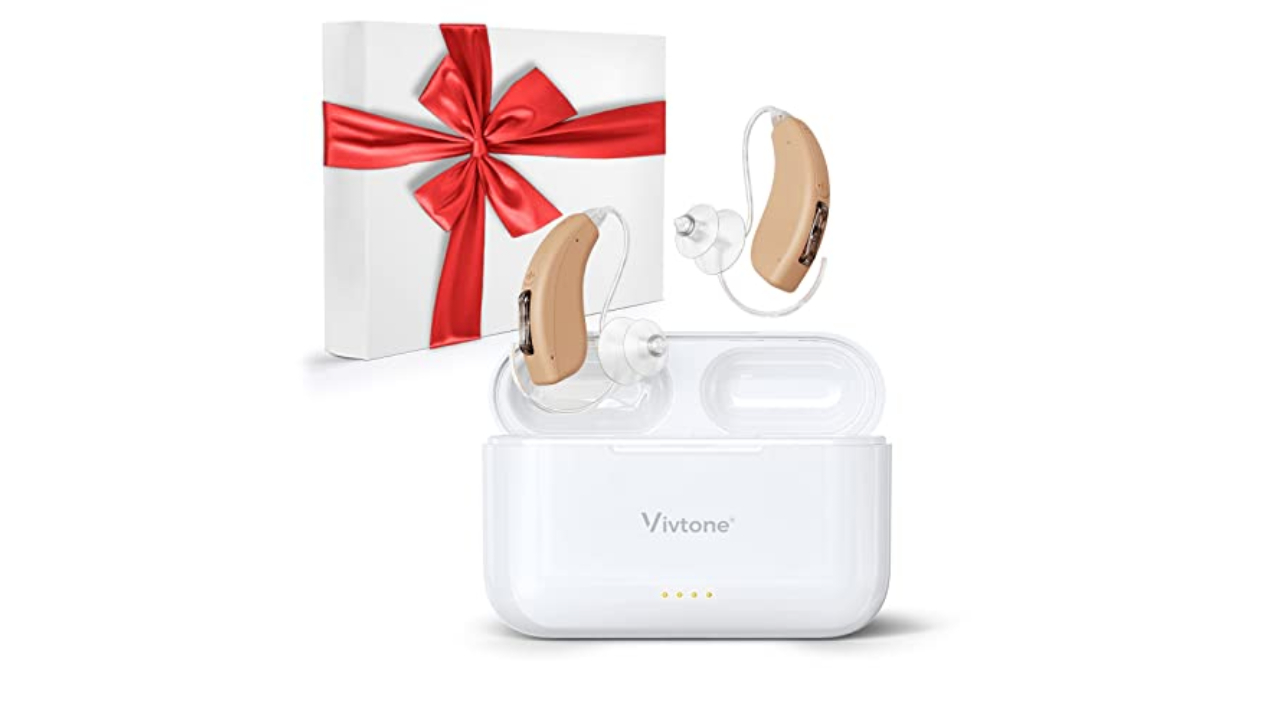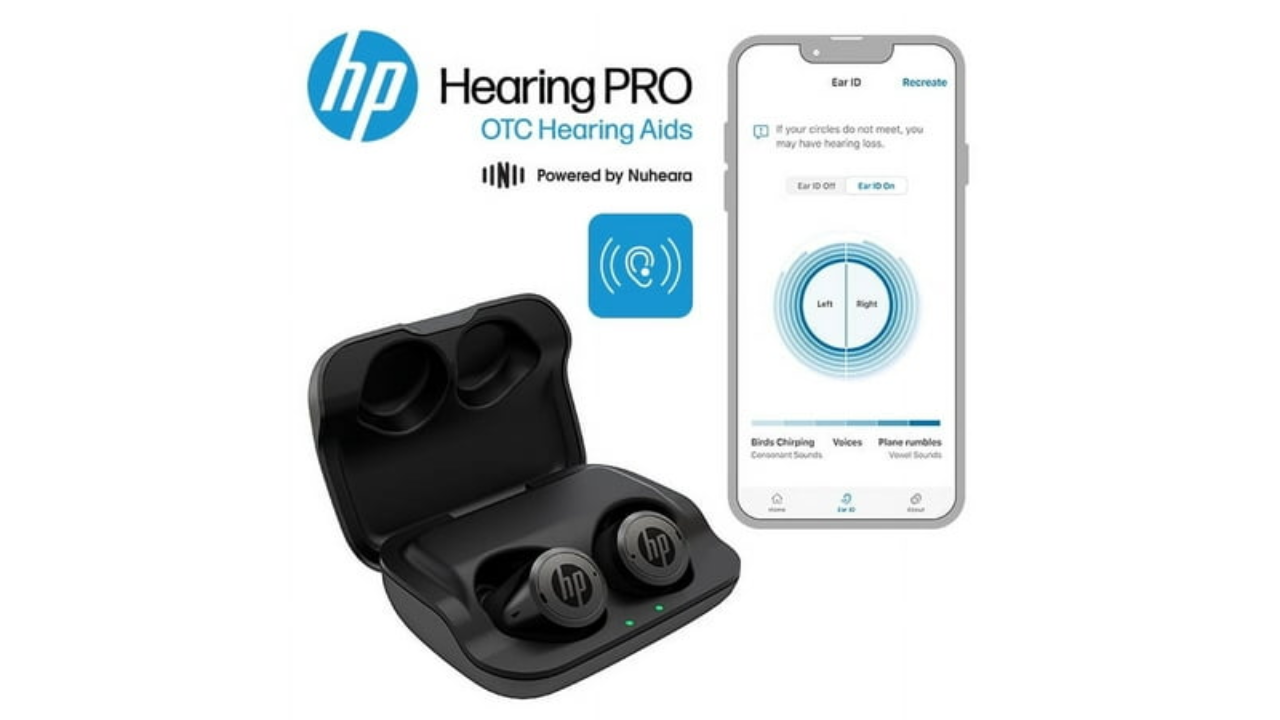We may earn commission from links on this page, but we only recommend products we believe in. Pricing and availability are subject to change.
The 8 best OTC hearing aids for seniors, according to audiologist and medical professionals
Did you know you can buy hearing aids over the counter? In the past, these life-changing devices required a prescription, but in 2022 the FDA approved the sale of OTC hearing aids, making the technology a lot more affordable and accessible. Soon after, major retailers such as CVS, Amazon and Best Buy hopped on board to offer hearing aids to buyers. These days, you’ll get to choose between purchasing an OTC option or going through your doctor for a prescription hearing aid. We’ll go over what you need to know about the differences between each so you can make the best decision, which begins with a better understanding of how these devices work.
Jabra Enhance Select 300
Best over-the-counter hearing aid overall
Eargo 7
Best invisible in-ear hearing aid
Lexie B2 Plus
Best for sound customization
Sony CRE-E10 Self-Fitting OTC Hearing Aids
Best sound quality
Audien ATOM PRO 2
Best ease of use
Lexie Lumen Self-Fitting Hearing Aids
Best customer service
Vivtone Lucid508 Rechargeable Hearing Aids
Best for moderate to significant hearing loss
HP Hearing PRO Self-Fitting OTC Hearing Aids
Best for mild-to-moderate hearing loss
While there is no way to reverse hearing loss, hearing aids can still enhance our everyday lives in a few ways, helping us to hear conversations more clearly or enjoy music and TV at a comfortable volume. Wearing hearing aids has also been linked to improving quality of life factors such as improved cognitive function and reduced risk of depression and dementia. Aging isn’t the only reason you might need hearing aids. Hearing loss can also be attributed to genetic mutations, noise exposure, exposure to therapeutic drugs that have ototoxic side effects and chronic conditions. In the past, the high cost of prescription hearing aids has traditionally prohibited many from having access to the best hearing aids, but that is no longer the case.
So we spoke with hearing experts, including audiologists and doctors, to better understand how OTC and prescription hearing aids compare. We then took their feedback and reviewed 20 of the best over-the-counter hearing aids on the market, looking at costs, sound quality, ease of set up, comfort, customer support and any special features unique to the hearing aid. Here are our top picks for the best over-the-counter hearing aids of 2024.
Best over-the-counter hearing aid overall
Cost: $1,595-$1,795 | Best for: Mild-to-moderate hearing loss | Covered by Insurance: Reimbursement available | FSA/HSA Eligible: Yes | Style of Fit: Receiver in canal (RIC) | Battery Type: Rechargeable | Remote/App customization: Yes
The Jabra Enhance Select 300 offers some of the most comprehensive features and support among the over-the-counter hearing aids we've reviewed. The Select 300 offers sound quality comparable to a prescription device, thanks to technology that includes a dual-core chip that enables it to differentiate between speech and background noise, automatically adjusting for clarity. Smart microphones and a powerful processor deliver more natural sound in complex situations while the built-in advanced noise cancelation allows for clearer sound in crowded areas. There's also enhanced spatial sense allowing for increased awareness of sounds coming from the sides and behind
This receiver-in-canal hearing aid is discrete and fits securely behind the ear. An invisible wire connects to a small speaker in the ear canal, which amplifies sound for those with mild-to-moderate hearing loss. It also has an IP67 rating for water and dust resistance, so it’s suitable for active lifestyles where moisture (rain, sweat, splashes) may be a concern.
There are two packages to choose from when purchasing: the premium package ($1,995) or the standard package ($1,795). Both come with a complete hearing aid set for the right and left ear and a charging case. The premium package also includes three years of audiology support, a better warranty, and damage and loss protection — which comes out to around $5.50 a month for the ongoing three years of professional adjustments and guidance.
The accompanying app lets you customize settings, or an audiologist can remotely make adjustments (premium package). The app also pairs with your other devices, such as a smartphone or TV, for streaming audio and calls directly to the hearing aid. However, limited phone compatibility may be a drawback for some. Users without an iPhone 11 or newer may need to purchase the Phone Clip+ accessory to take advantage of hands-free calling.
If you are unsure if you need a hearing aid or if this is the best hearing aid for you, Jabra offers an online hearing test.
- 100-day trial period
- Premium package includes access to audiologists
- Advanced customization options with premium package
- Hands-free calling only available for iPhone 11 and newer
- Only suitable for mild to moderate hearing loss
- Requires smartphone or tablet
Other top over-the-counter hearing aids we recommend for 2024
Cost: $2,550 | Best for: All levels of hearing loss | Covered by Insurance: Yes | FSA/HSA Eligible: Yes | Style of Fit: Completely-in-canal (CIC) | Battery Type: Rechargeable | Remote/App customization: Yes
The Eargo 7 is a completely-in-canal hearing aid that boasts an almost invisible-to-the-naked-eye design. Its small size and low profile make it a discreet option when aesthetics are a priority. The hearing aid sits deep in the ear canal, so it's less prone to being knocked out of place or falling out. The soft, flexible silicone-petal tips flex to conform to your ear's shape — additional sizes are included in your box if needed.
The Eargo app works with the hearing aids for remote adjustments and control. There's no physical volume wheel or buttons, but you can adjust through three sound profiles by tapping your ear (after initial app programming). The app also allows you to change volume, filtering, and programs with the touch of a button. If you need help with your Eargos, the app includes video chat support for professional guidance.
One downside is that the Eargo 7 doesn't have Bluetooth connectivity for streaming audio. Still, its automatic sound technology adapts to each environment — transitioning between music, phone calls, or conversation. Although it may not be the most affordable option, it includes ongoing customer support and an up to two-year warranty. Plus, some insurance plans may cover part or all of the cost.
- Discreet, virtually invisible design
- Lifetime virtual support
- Self-fitting
- More expensive than other OTC brands
- No Bluetooth streaming
Cost: $999 | Best for: mild-to-moderate hearing loss | Covered by Insurance: No | FSA/HSA Eligible: Yes | Style of Fit: Receiver in canal (RIC) | Battery Type: Rechargeable | Remote/App customization: Yes
We chose the Lexie B2 hearing aid by Bose as our pick for the best customization, thanks to the robust app that offers multiple features based on your individual hearing profile. The Lexie B2 Plus is a self-fitting hearing aid, which means that the settings are programmed for your specific hearing needs using the app's built-in hearing test that helps you find the perfect settings for your hearing profile. The hearing aids are also equipped for hands-free phone calls (iPhone only) and music streaming; this is a product created by Bose, a leader in sound quality.
Additionally, the app allows you to easily connect with a Lexie hearing expert who can offer support via video, chat, or phone. While some OTC hearing aid brands give you a set time for free support, Lexie offers ongoing, lifetime support. Customer service is also available seven days a week.
- Free ongoing professional support
- Customer service available 7-days a week
- Lifetime support
- Streaming not compatible with Android
- Only available in gray
Cost: $1,300 | Best for: mild-to-moderate hearing loss | Covered by Insurance: No | FSA/HSA eligible: Yes | Style: In-the-ear (ITE) | Remote/app customization: Yes
The Sony CRE-E10 hearing aid looks like your average earbuds, and with sound quality to match. The sound profile is richer compared to other models, with controls for volume, balance, and directionality of sound in the app. These in-the-ear hearing aids are water- and dust-resistant with an IP68 rating, so you can wear it while exercising or in light rain.
You'll need to use the Sony Hearing Control app (available for iOS and Android) to control your hearing aids' settings. This model doesn't have physical buttons for manual control. Instead, you can adjust everything through the app, including fine-tuning for different environments. It's worth noting that those with Android devices don't have the same connectivity options for streaming audio, which may be a dealbreaker for some.
The CRE-E10 hearing aids come with four sizes of silicone tips, a charging case, and cleaning accessories. Sony estimates the batteries last up to 26 hours on a single charge — more than most. You can also use your health savings account (HSA) or flexible spending account (FSA) toward this purchase.
- Water and dust-resistant
- App for adjusting volume and sound settings
- Battery lasts up to 26 hours
- No buttons for manual control
- Not Bluetooth streaming compatible with Android
Cost: $289 | Best for: mild-to-moderate hearing loss | Covered by Insurance: No FSA/HSA eligible: Yes | Style: In-the-canal (ITC) | Remote/app customization: No
When it comes to ease of use out of the box, the Audien Atom Pro 2 has all the basics covered without the extras that can complicate setup. These in-the-canal hearing aids are 28% smaller than previous Audien models to fit more comfortably in your ear. The benefit of its simplistic design is its ease of use. You don't need a smartphone or app to control the volume or programs, which is ideal for those who aren't tech-savvy.
The downside is that customization is limited. There aren't any preset listening profiles or advanced settings, and you'll have to remove the hearing aids to change the volume. Its impressive battery can last up to 24 hours on a single charge.
The Atom Pro 2 also has a UV charging case that eliminates bacteria and keeps your hearing aids clean. The company offers a 45-day money-back guarantee, and you can purchase using your HSA or FSA card.
- Relatively discrete
- No smartphone or app needed
- Battery lasts up to 24 hours
- Lacks advanced customization
- Manual adjustments take longer
Cost: $799 ($699 via Amazon) | Best for: Mild-to-moderate-hearing loss | Covered by Insurance: No | FSA/HSA eligible: Yes | Style: Behind-the-ear (BTE) | Remote/app customization: Yes
The Lexie Lumen stands out for having many of the same features as the Lexie B2 Plus, including exceptional lifetime hearing aid support via the app. While this model will cause you to forgo hands-free calls and streaming, it does have a telecoil that functions as an antenna to provide crisp, clean sound directly to your hearing aids. Using the Lexie Remote app, you'll connect via Bluetooth to your hearing aids to change the sound settings and listening profiles according to your personalized hearing test. There are six listening profiles for different situations — Every day, noisy indoor, outdoor, music, telecoil and companion mic. When it comes to fit, this is a behind-the-ear (BTE) hearing aid that connects to an earpiece via a clear tube. You can choose from five neutral colors: beige, gray, bronze, silver, and metallic black.
Unlike any other manufacturer on this list, hearing aid and general support are available seven days a week via the app with the choice of video, chat or live phone call response. It's worth noting that the batteries aren't rechargeable and need replacing every four to seven days, depending on use.
Lexie offers a 45-day trial period. If you decide they're not for you within that time frame, return the aids for a refund.
- In-app hearing test for personalizing your settings
- 45-day trial period
- Customer service available 7-days a week
- No streaming or hands-free phone calls
- Batteries need replacing every four to seven days
Cost: $249 |Best for: Mild-to-significant hearing loss | Covered by Insurance: No FSA/HSA eligible: Yes | Style: IBehind the ear (BTE) | Remote/app customization: No
If you suffer from mild to significant hearing loss and are looking for a budget-friendly hearing aid, then the Vivtone Lucid508 is worth your consideration. The Lucid508 is a rechargeable digital hearing aid with three professional modes: natural and clear sound quality, noise cancellation and tinnitus masking. You can easily switch between the three professional modes — Normal listening mode, Noisy environment mode and Tinnitus masking mode — with a quick tap of a button on the hearing aid, no downloading apps or sign-up needed. You can also skip fumbling with tiny batteries as these are fully rechargeable and run for about 30 hours between charges, with the case holding 125 hours of backup charge or about four full charging cycles. The hearing aids are also incredibly small and discreet so only you know you are wearing a hearing aid.
Many users were pleasantly surprised with how well the hearing aids worked out of the box, requiring little to no setup. It "worked great right out of the package," exclaimed a reviewer.
- 45-day money back gurantee
- Designed for mild to significant hearing loss
- Charging case holds 150 hours of backup power
- May not be great for those with tinnitus
Cost: $499 | Best for: Mild-to-moderate-hearing loss | Covered by Insurance: No | FSA/HSA eligible: Yes | Style: In-the-ear (ITE) | Remote/app customization: Yes
The HP Hearing Pro has an earbud-like design that rests inside the ear similar to a pair of wireless earbuds. Notably, this product is the first to receive FDA clearance under a new category of hearing devices called “Self-Fitting Air-Conduction Hearing Aid, Over The Counter.” The self-fitting feature allows you to calibrate your device through the app-based program without a professional hearing test. Note: We still recommend consulting with an audiologist for a proper diagnosis.
The HP Hearing Pro also offers several listening modes for different environments, streaming capabilities, and a portable charging case. The battery life lasts approximately eight hours for everyday hearing and five hours for streaming. While this is lower than many other OTC models, it boasts the average battery life of standard wireless earbuds.
The company offers a two-year warranty (higher than most) and a 45-day trial period, making it a solid choice for those with mild-to-moderate hearing loss seeking an affordable option.
- Simple earbud design
- Automatic calibrations
- Works with Android and iOS
- Only available in one color (black)
- Lower battery life than other models
Factors to consider when choosing over-the-counter hearing aids
Style of hearing aid: There are multiple styles of hearing aids, each of which caters to different aesthetics and functionality.
Behind-the-ear (BTE): These rest behind the ear while a plastic tube directs amplified sound into the ear canal through an ear mold. BTE hearing aids are suitable for most types of hearing loss and are the most visible type.
Receiver-in-canal (RIC): Similar to BTEs but with the speaker or receiver placed inside the ear canal. Their size reduction often makes them less visible and more comfortable, and they can provide natural sound quality.
In-the-ear (ITE): Most ITEs are custom-made and fit within the outer ear; ITE aids are easier to handle and are often a top pick due to their discreet profile.
In-the-canal (ITC): Many of these devices are custom molded and fit partly in the ear canal, making them less noticeable than ITE models.
Completely-in-canal (CIC): This is the most discrete option that fits deep inside the ear canal. These are typically custom-fitted to be nearly invisible and are well-suited for mild to moderate hearing loss. However, they may be challenging for users with dexterity issues due to their small size.
Cost: Hearing aids can cost anywhere from a few hundred to several thousand dollars. Some insurance plans may cover hearing devices partially or entirely, and certain models are eligible as an FSA/HSA-approved expense. Consider your budget, insurance, and whether batteries and accessories are included in the cost.
Prescription or OTC: Prescription hearing aids require a medical evaluation and fitting by an audiologist, while OTC options are purchased without a prescription. An OTC model may be suitable if you have mild to moderate hearing loss and are comfortable with technology. On the other hand, a prescription hearing aid is likely the best option if you have moderate to severe hearing loss or prefer professional fitting and support. According to audiologist Dr. Leigh Smith, whether you opt for a prescription or OTC model, a professional evaluation should be the first step to assess for any underlying medical conditions and determine the appropriate level of amplification needed.
Set-up: Prescription hearing aids require professional fitting and calibration, while OTC options are generally self-fitting. Users adjust the volume manually or use an app to customize sound settings and frequency. However, some OTC options now offer remote programming and assistance from a hearing professional. Remote access allows you to send data and receive tailored adjustments from an audiologist without an in-person visit.
App pairing: Basic models use physical buttons to adjust volume and settings, whereas many newer hearing aids offer a companion app for customizing sound profiles and tailoring the amplification level based on your environment. Consider whether you prefer a model with app pairing capabilities or if standard controls are sufficient.
Bluetooth capabilities: Models that connect to your smartphone via Bluetooth are great for streaming music, phone calls, and audio directly from the device, eliminating the need for headphones or an external speaker. If this is a feature you want, ensure your chosen model has Bluetooth capabilities and is compatible with your smartphone.
Extra features: Many hearing aids offer additional features such as rechargeable batteries, directional microphones, wind noise reduction, extended battery life, and advanced noise cancellation. Trial periods, warranty lengths, and professional support are also important, as each OTC model comes with varying levels of support.
How we chose
We spoke with hearing experts, including audiologists and otolaryngologists, to understand the types of hearing loss that may be suitable for OTC options. We also considered the features and specifications of different models, including price, sound quality, customization options, and support included after purchase. After researching a dozen brands and more than 50 models, we chose our top picks based on expert input, customer reviews, quality, and value for the cost. We also considered the availability of trial periods and warranties to protect your purchase.
FAQs
Who should consider over-the-counter hearing aids?
Dr. Smith warns that not everyone with hearing loss should consider purchasing OTC hearing aids. For those with severe or profound hearing loss, tinnitus, ear infections, drainage, or those who have undergone ear surgery or have structural ear issues, the best course of action is to work with an audiologist.
Dr. Smith adds that if you wish to pursue OTC hearing aids as a matter of cost savings, you should do the following to ensure safety and efficacy:
Have your hearing tested by a professional to confirm your mild to moderate hearing loss?
Verify the return period of the device in case it doesn’t work properly or isn’t a good fit.
Visit a hearing care professional who utilized Real Ear Measurements (REM) after the OTC purchase to confirm if the hearing aids apply the appropriate volume amount based on your hearing test.
If you've already had a hearing evaluation and are confident in the level of amplification needed, an OTC model can be a cost-effective and convenient option. The most crucial factor to consider is whether the device meets your needs and preferences and provides the necessary amplification for your specific type of hearing loss.
How do hearing aids work?
“Hearing aids are designed to not just amplify sound but to do so in a way that improves speech clarity and understanding,” says Dr. Amy Sarow, a clinical audiologist. They consist of several components, including a microphone, amplifier, speaker, and battery. The microphone picks up sound from around you and converts it into electrical signals. The amplifier then increases the strength of these signals before sending them to the speaker, which converts them back to sound waves and delivers them into the ear canal. The battery provides power to all of these components.
Modern hearing aids also include advanced technology, such as digital signal processing, noise reduction algorithms, and Bluetooth connectivity, to provide a more personalized and seamless listening experience. These features can help reduce background noise, improve speech clarity, and allow for direct streaming of audio from devices such as smartphones or televisions.
What is the difference between OTC and prescription hearing aids?
The main difference between OTC and prescription hearing aids lies in the level of customization and professional support. Prescription hearing aids require a medical evaluation and fitting by an audiologist, while OTC options can be purchased without a prescription.
“Prescription devices are fit precisely by a hearing professional to an individual's audiogram to provide specific amplification tailored to their hearing loss,” says Dr. Sarow. “For instance, if a person's lower-frequency hearing is normal or has mild loss, the hearing aid is programmed to offer minimal amplification in those ranges while providing more volume at higher frequencies where hearing loss is more pronounced.”
On the other hand, OTC hearing aids allow users to self-tune their devices via a test or other app-based feature, according to Dr. Sarow.
“For some individuals who are comfortable with technology, [OTC hearing aids] may provide an alternative to the traditional prescriptive approach to fitting hearing aids,” says Dr. Dave Fabry, Starkey’s chief hearing health officer. “While this may serve as an entry into hearing aids for those with perceived mild-to-moderate hearing loss, it removes the hearing professional who is an essential resource for diagnosing and treating hearing loss and for selecting the best technology to meet the individual’s needs,” he adds.
Prescription hearing aids also tend to offer more ongoing support from a hearing professional to ensure the best fit and performance. Dr. Smith cautions that many people using OTC hearing aids are either over or under-amplified, which can lead to discomfort or further damage to the hearing. This results from not having the device professionally fitted and adjusted.
“We believe that the best patient outcomes are achieved when our technology is fitted by a qualified professional,” says Dr. Fabry.
Are OTC hearing aids as good as prescription hearing aids?
“OTC hearing aids are a good choice for early-stage hearing loss,” says Dr. Sreek Cherukuri, a board-certified ear, nose, and throat physician, who also recommends seeing an audiologist first. They may be ideal for those who want to avoid the often high costs of prescription hearing aids. However, he also notes that OTC models are difficult for users to adjust, leading to potential issues in finding the right amplification level.
Does Medicare cover OTC hearing aids?
Dr. Cherukuri says traditional Medicare does not cover hearing aids. “Some Medicare Advantage [Part C] and some employer-based insurance have hearing aid coverage,” he says. Private insurance coverage varies based on your carrier and plan. It’s best to check with your insurance carrier for coverage options.
How do I know if I need a hearing aid?
It may be time to consider a hearing aid if you are experiencing difficulty hearing, especially in social situations or conversations with background noise. “The average individual waits 7-10 years after they first notice hearing loss to take steps toward addressing their changes in hearing,” says Amanda Cooper, licensed hearing aid specialist. “Hearing loss is correlated with a multitude of health conditions as well as social isolation, which can impact an individual's quality of life.” Report any changes in your hearing to a medical professional who can help determine if a hearing aid is appropriate. “The earlier hearing loss is detected and treated, the better,” Cooper adds.
Are hearing aids easy to set up?
Every model is different, but most OTC hearing aids have a user manual and online tutorials to help you set them up. If you have any difficulty, customer support is usually available. Prescription hearing aids require professional fitting and calibration by an audiologist. Depending on the model, you may also need to visit your audiologist regularly for adjustments and maintenance.
Meet our experts
Amanda Cooper, licensed hearing aid specialist
Dr. Leigh Smith, AUD, audiologist and owner of Florida Audiology Associates, a hearing clinic located in Tampa, Florida
Dr. Dave Fabry, PhD, Starkey’s chief hearing health officer
Dr. Amy Sarow, clinical audiologist
Dr. Sreek Cherukuri, MD, board-certified ear, nose, and throat physician and founder of ClearCast





